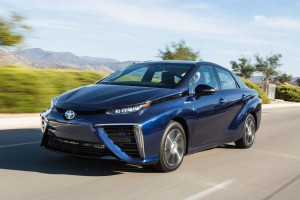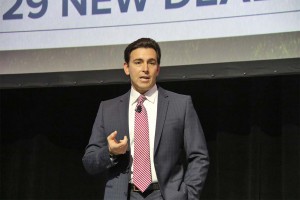In a historic move, 196 countries – from small Pacific island nations to economic powerhouses like the U.S., Germany and China – have signed on to support the climate change accord negotiators hammered out in Paris over the weekend.
“History will remember this day,” UN Secretary-General Ban Ki-moon said of an agreement expected to lead to a massive shift away from the use of fossil fuels. That is seen as key to efforts aimed at minimizing global temperature increases and a predicted rise in sea levels.
The accord came after a marathon, 48-hour session in the City of Lights. Paris was an apt place for the negotiations to take place as it has had to take emergency steps several times to deal with increasing air pollution problems in recent years. Going forward, the city will see a shift in how it powers the beacon atop the familiar Eiffel Tower, as well as the cars that crawl along its ring highway, the Peripherique, during rush hours.
“The work starts tomorrow,” added the UN chief. “Markets now have the clear signal to unleash the full force of human ingenuity.”
Consumers in France won’t be alone in seeing changes. And motorists are likely to directly see some of the biggest changes from the climate change agreement.
Burning a gallon of gas produces nearly 20 pounds of carbon dioxide. A gallon of diesel means more than 22 pounds of CO2 flows into the atmosphere. The Energy Information Administration estimates that total CO2 produced by automobiles in the U.S. came to 1,519 million metric tons in 2014. That was 83% of the emissions from the overall energy sector and 28% of total U.S. energy-related CO2 emissions.
The U.S. has the world’s largest automotive fleet, with nearly one vehicle for every man, woman and child. But the global fleet is expanding rapidly, with nearly 1 billion vehicles on the road, and by decade’s end, IHS Automotive has forecast sales will be approaching 100 million new vehicles annually. While some of those will be replacement models, a large share will go to first-time buyers, especially in emerging markets like India and China.
With some of the worst air pollution problems in the world, those two nations are already struggling to figure out how to take the automobile out of the environmental equation. After issuing a red alert this month, Beijing put severe restrictions on driving, and more than a dozen Chinese cities now have registration limits meant to slow the growth of sales.
The exception is for qualified vehicles using alternative propulsion systems, primarily battery power. Significantly, China is expected to push past the U.S. this year to become the world’s largest market for electrified vehicles.
Whether regulators now enact even tougher rules as a result of the Paris climate accord is uncertain, but with tough new federal mileage standards – and strict zero-emissions vehicle rules in California, the U.S. is expected to see more and more battery-based vehicles on the road in the years ahead.
Ford Motor Co., for one, last week revealed plans to invest $4.5 billion in electrification by 2020, adding 13 new battery-based models to the list of six it currently offers. While CEO Mark Fields wouldn’t discuss specifics, he hinted that the list will include a number of plug-in hybrids. That appears to be the sweet spot for many makers – Mercedes-Benz planning to add 10 by 2018 – allowing zero-emissions motoring for errands and commutes, and back-up gas power for longer trips.
(Ford to invest $4.5 bil in new “electrified” vehicles by 2020. Click Here for the full story.)
Not everyone is betting on batteries. Three makers: Toyota, Hyundai and Honda, will soon be selling hydrogen cars in the U.S. Proponents believe fuel-cell vehicles are the ultimate in emissions-free driving, as they offer, among other things, longer range and quick refills.

The Toyota Mirai fuel-cell vehicle is now on sale in California. Honda's hydrogen car comes in 2016.
Conventional gasoline engines aren’t likely to vanish entirely. But expect them to be downsized significantly, using turbochargers, superchargers, electric turbos and various levels of hybridization to improve both mileage and performance.
Consumer acceptance is, of course, the critical uncertainty, analysts stress. Fuel cells currently are limited to a small region of Southern California where there are a handful of hydrogen pumps. Demand for battery cars has been restricted by high costs, low range and long charging times.
(Chevrolet Volt named Green Car of the Year. Click Here for the story.)
On the positive side, lawmakers and private industry have begun teaming up to add more hydrogen fueling stations and battery charging stations. A new consortium, ROEV, will not only bring more high-speed chargers to U.S. highways, but also make it easier for motorists to use them.
And prices on batteries are falling rapidly, potentially making electrified vehicles more cost-competitive. Where a kilowatt-hour of batteries cost as much as $1,000 at the beginning of the decade, that is now approaching $150. On a vehicle like the 200-mile Chevrolet Bolt, that means a savings of as much as $50,000.
Whether that will sway consumers is far from certain, but they may not have much choice. A dozen states now follow the stricter California emissions and mileage rules, for one thing. Whether still tougher standards will follow on the federal level is uncertain. Republican opposition to the new climate bill has already been intense. Senator James Inhofe, the head of the Senate Environment and Public Works Committee, declared the new Paris accord “full of hot air.”
The Obama Administration promises to work with – or around Congress, Secretary of State John Kerry insisting, “This has to happen.”
Outside the U.S., motorists likely will see even more significant changes, and not just in authoritarian countries like China. Hamburg, Copenhagen and Helsinki are among the cities considering strict new limits on motor vehicles, possibly barring access to city centers or limiting privately owned vehicles. A number of cities are expected to limit access to only those vehicles operating in pure electric mode.
At a background briefing for reporters last week, Ford outlined a number of new projects it is working on, including car- and ride-sharing programs that would offer alternatives to personal vehicle ownership. The goal, said CEO Fields, is “understanding what the world will look like in five, 10, 15 years.”
Combine the changes demanded by the Paris climate accord with the fact that more and more people will be living in mega-cities, and the situation is likely to be very different from today. It very well could mean both more alternatives to driving and the likelihood that the cars we will drive will be far cleaner and more fuel-efficient than today.
(Nissan working on new extended-range electric vehicle. Click Here for more.)



Now the progressive liberals wealth redistribution scam . Hopefully some common sense will prevail in congress and or the next administration and they will bounce the checks the limousine liberals are trying to write with our money .
There are no enforcement[ very likely] most of the participants with their hands out for green $$$$ aren’t going to slow down their development and economys for real carbon emission reductions anyway.
Thankfully the populace can remove unscrupulous politicians from office. It’s great to be proactive in trying to improve the planet but not at the expense of harming society as a result of irrational schemes and predictions.
exactly I’m hoping 2016 brings some changes